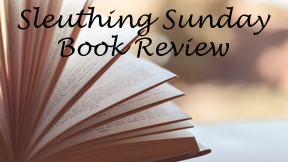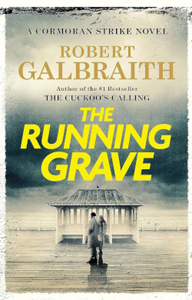In “The Running Grave” (2023, hardcover), Robin Ellacott spends months undercover in a cult church compound to gather evidence. This section is long enough to be its own novel, yet it takes up less than 50 percent of this seventh Cormoran Strike tome by Robert Galbraith (J.K. Rowling). Such is the length (to be blunt) or epic nature (to be literary) of this 945-page doorstop.
By the end, we’re as exhausted (but also as satisfied) as Robin and Strike as we see the legwork and brainpower that must go into exposing the criminal activities and depravities of the long-established Universal Humanitarian Church.
As always, these Strike novels stand out from the genre pack by including not only the featured case, but also bits of the agency’s other cases, and the other life problems for the two leads. As Rowling well knows, life does not pause so a person can focus on work.

“The Running Grave” (2023)
Author: J.K. Rowling (writing as Robert Galbraith)
Series: Cormoran Strike No. 7
Genre: Mystery
Setting: London, Norfolk and other parts of the U.K.; 2016
Grave concerns
“The Running Grave’s” primary theme is the way in which an individual can be brainwashed. Through Robin’s horrific experiences inside the fences, we see how even an intelligent, worldly person can be worn down via a limited diet, a lack of clocks or calendars, exhausting labor, and religious ceremonies that utilize magic tricks and play on emotions. Songs from David Bowie and R.E.M. are disturbingly recontextualized to sell church leader Jonathan “Papa J” Wace’s pitch that it has the answers to the evils of the world.
Although there’s never doubt that the church is doing awful things – it’s just a question of the degree and the quantity, and Rowling ultimately pushes those to remarkable lengths – “The Running Grave” also cleverly positions it as the antithesis to things that are demonstrably bad in the world.
These include climate change and authoritarian governments that promote endless war. Rowling’s politics are what they’ve always been – she’s not a fan of the warfare state, but she does believe governments can do enough other good things to be worthy of existing. (As is clear from “The Casual Vacancy,” she doesn’t believe the warfare state and welfare state are necessarily two sides of a coin.) But she also illustrates bureaucratic frustration via Strike’s and Robin’s often-quashed attempts to convince the police that the UHC should be raided.
Interestingly, the author warns that a “live and let live” philosophy can lead to organizations like the UHC thriving. She includes no government-UHC cross-corruption in the narrative, but the fact that some celebrities are among UHC’s biggest donors – and that they benefit from the child sex trafficking branch of the operation – is perhaps inspired by recent headlines. (As the book is set in 2016, before those revelations, she makes no overt links.)

While Papa J is handsome, charismatic and an incredible orator, his primary wife (he also takes several “spirit wives”) Mazu is Rowling’s most striking villain since Dolores Umbridge in “Harry Potter and the Order of the Phoenix.” She’s like a classic portrayal of a witch, highlighted by Robin’s observation of Mazu’s unwashed stench. Rowling has sympathy for authority in an abstract sense, but certainly recognizes organizations can fester with evil, powerful individuals.
Almost drowning in complexity
As a mystery, “The Running Grave” provides page-turning power more from the grotesqueries than from puzzle construction, as it centers on a core UHC prophet, Daiyu Wace, one of many daughters of Papa J. She’s known as The Drowned Prophet, and Strike and Robin spend a fair amount of time mulling the child’s (supposed) drowning in the sea decades ago.
While the final answer about the Daiyu case is satisfying, Rowling doesn’t give readers much of a chance to solve it. Not because the clues aren’t in there somewhere, but because there’s so much going on within each sub-mystery and in the overall case. Indeed, Strike – who has a bulletin board in his office filled with photographs, facts and pertinent questions – realizes this case will be solved by sorting the relevant information from the irrelevant.
“The Running Grave” is short on humor – with my smirks coming from the way Strike and Robin are always thinking about each other, with neither of them knowing the other is doing it – but is not pure bleakness. This is because if the UHC is exposed, its victims (some of whom we’ve come to sympathize with) will have better lives. It’s fascinating to see how the case snowballs in a positive direction, a contrast to the snowball of negatives experienced by Robin within the fences, as more ex-members give evidence.
Some readers enjoy these books for the Strike-Robin relationship developments. While it’s not my main reason for reading the series – I’m one of those oddballs who could watch “The X-Files” without needing Mulder and Scully to pair up – I admit Rowling writes emotional feelings well, and delivers a key development at the end.
The Strike series has now tied “Harry Potter” with seven novels, but this time it’s clear seven is not the end point. In some ways, things are merely beginning. I’ll be on board for book eight, even if I must set aside a month to read it.
Sleuthing Sunday reviews the works of Agatha Christie, along with other new and old classics of the mystery genre.

